Crossref Citations
This article has been cited by the following publications. This list is generated based on data provided by
Crossref.
Zhao, Shijun
Stocks, G. Malcolm
and
Zhang, Yanwen
2017.
Stacking fault energies of face-centered cubic concentrated solid solution alloys.
Acta Materialia,
Vol. 134,
Issue. ,
p.
334.
Chakraborty, Debajit
and
Aidhy, Dilpuneet S.
2017.
Cr-induced fast vacancy cluster formation and high Ni diffusion in concentrated Ni-Fe-Cr alloys.
Journal of Alloys and Compounds,
Vol. 725,
Issue. ,
p.
449.
Zhao, Shijun
Osetsky, Yuri
and
Zhang, Yanwen
2017.
Preferential diffusion in concentrated solid solution alloys: NiFe, NiCo and NiCoCr.
Acta Materialia,
Vol. 128,
Issue. ,
p.
391.
Zhao, Shijun
Weber, William J.
and
Zhang, Yanwen
2017.
Unique Challenges for Modeling Defect Dynamics in Concentrated Solid-Solution Alloys.
JOM,
Vol. 69,
Issue. 11,
p.
2084.
Zhang, Yanwen
Zhao, Shijun
Weber, William J.
Nordlund, Kai
Granberg, Fredric
and
Djurabekova, Flyura
2017.
Atomic-level heterogeneity and defect dynamics in concentrated solid-solution alloys.
Current Opinion in Solid State and Materials Science,
Vol. 21,
Issue. 5,
p.
221.
Velişa, Gihan
Ullah, Mohammad W.
Xue, Haizhou
Jin, Ke
Crespillo, Miguel L.
Bei, Hongbin
Weber, William J.
and
Zhang, Yanwen
2017.
Irradiation-induced damage evolution in concentrated Ni-based alloys.
Acta Materialia,
Vol. 135,
Issue. ,
p.
54.
Zhao, Shijun
Velisa, Gihan
Xue, Haizhou
Bei, Hongbin
Weber, William J.
and
Zhang, Yanwen
2017.
Suppression of vacancy cluster growth in concentrated solid solution alloys.
Acta Materialia,
Vol. 125,
Issue. ,
p.
231.
Levo, E.
Granberg, F.
Fridlund, C.
Nordlund, K.
and
Djurabekova, F.
2017.
Radiation damage buildup and dislocation evolution in Ni and equiatomic multicomponent Ni-based alloys.
Journal of Nuclear Materials,
Vol. 490,
Issue. ,
p.
323.
Ullah, Mohammad W.
Xue, Haizhou
Velisa, Gihan
Jin, Ke
Bei, Hongbin
Weber, William J.
and
Zhang, Yanwen
2017.
Effects of chemical alternation on damage accumulation in concentrated solid-solution alloys.
Scientific Reports,
Vol. 7,
Issue. 1,
Zhang, Yanwen
Xue, Haizhou
Zarkadoula, Eva
Sachan, Ritesh
Ostrouchov, Christopher
Liu, Peng
Wang, Xue-lin
Zhang, Shuo
Wang, Tie Shan
and
Weber, William J.
2017.
Coupled electronic and atomic effects on defect evolution in silicon carbide under ion irradiation.
Current Opinion in Solid State and Materials Science,
Vol. 21,
Issue. 6,
p.
285.
Zhao, Shijun
Osetsky, Yuri N.
and
Zhang, Yanwen
2017.
Atomic-scale dynamics of edge dislocations in Ni and concentrated solid solution NiFe alloys.
Journal of Alloys and Compounds,
Vol. 701,
Issue. ,
p.
1003.
Farkas, Diana
and
Caro, Alfredo
2018.
Model interatomic potentials and lattice strain in a high-entropy alloy.
Journal of Materials Research,
Vol. 33,
Issue. 19,
p.
3218.
Sachan, Ritesh
Ullah, Mohammad W.
Chisholm, Matthew F.
Liu, Jie
Zhai, Pengfei
Schauries, Daniel
Kluth, Patrick
Trautman, Christina
Bei, Hongbin
Weber, William J.
and
Zhang, Yanwen
2018.
Radiation-induced extreme elastic and inelastic interactions in concentrated solid solutions.
Materials & Design,
Vol. 150,
Issue. ,
p.
1.
Chakraborty, D.
Harms, A.
Ullah, Mohammad W.
Weber, W.J.
and
Aidhy, D.S.
2018.
Effect of atomic order/disorder on vacancy clustering in concentrated NiFe alloys.
Computational Materials Science,
Vol. 147,
Issue. ,
p.
194.
Jin, Ke
and
Bei, Hongbin
2018.
Single-Phase Concentrated Solid-Solution Alloys: Bridging Intrinsic Transport Properties and Irradiation Resistance.
Frontiers in Materials,
Vol. 5,
Issue. ,
Shi, Shi
He, Mo-Rigen
Jin, Ke
Bei, Hongbin
and
Robertson, Ian M.
2018.
Evolution of ion damage at 773K in Ni- containing concentrated solid-solution alloys.
Journal of Nuclear Materials,
Vol. 501,
Issue. ,
p.
132.
Jin, Miaomiao
Cao, Penghui
and
Short, Michael P.
2018.
Thermodynamic mixing energy and heterogeneous diffusion uncover the mechanisms of radiation damage reduction in single-phase Ni-Fe alloys.
Acta Materialia,
Vol. 147,
Issue. ,
p.
16.
Correa, Alfredo A.
2018.
Calculating electronic stopping power in materials from first principles.
Computational Materials Science,
Vol. 150,
Issue. ,
p.
291.
Lu, Chenyang
Yang, Taini
Niu, Liangliang
Peng, Qing
Jin, Ke
Crespillo, Miguel L.
Velisa, Gihan
Xue, Haizhou
Zhang, Feifei
Xiu, Pengyuan
Zhang, Yanwen
Gao, Fei
Bei, Hongbin
Weber, William J.
and
Wang, Lumin
2018.
Interstitial migration behavior and defect evolution in ion irradiated pure nickel and Ni-xFe binary alloys.
Journal of Nuclear Materials,
Vol. 509,
Issue. ,
p.
237.
Nygren, K.E.
Bertsch, K.M.
Wang, S.
Bei, H.
Nagao, A.
and
Robertson, I.M.
2018.
Hydrogen embrittlement in compositionally complex FeNiCoCrMn FCC solid solution alloy.
Current Opinion in Solid State and Materials Science,
Vol. 22,
Issue. 1,
p.
1.
